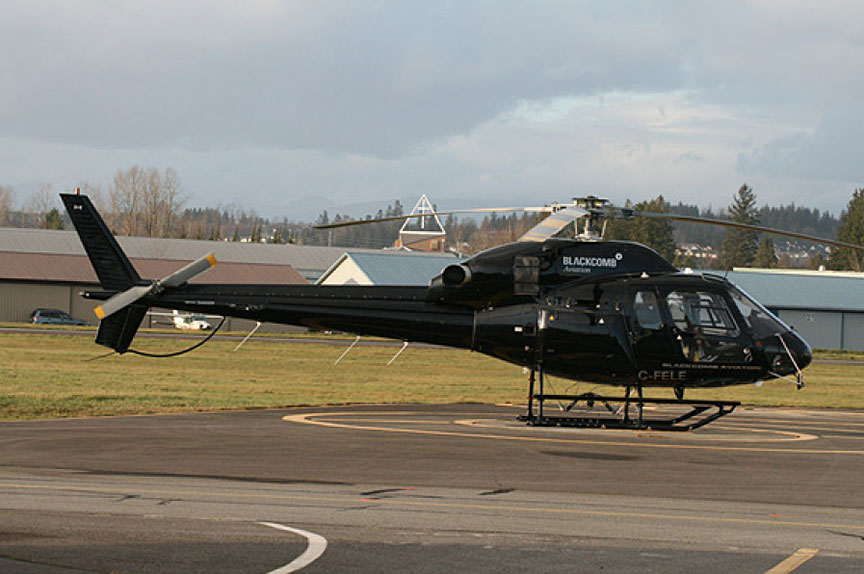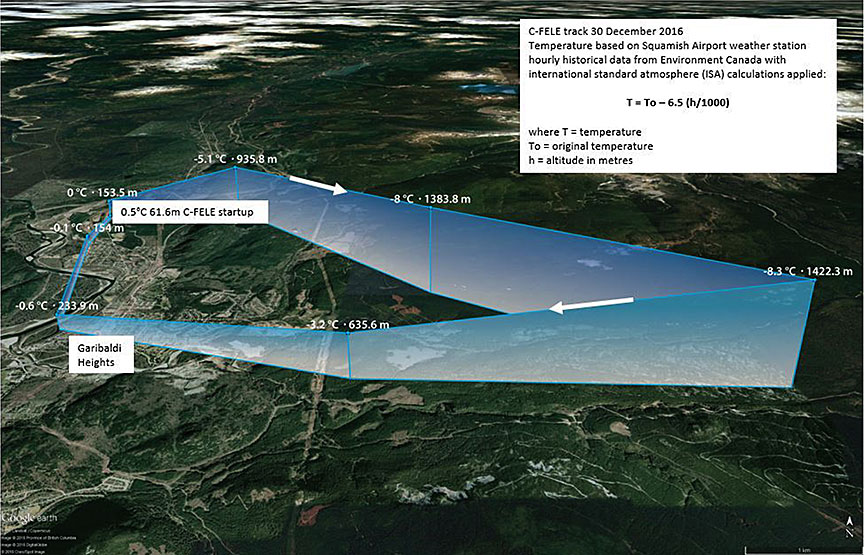Temporary difficulty with aircraft control
Blackcomb Helicopters LP
Aérospatiale AS355N, C-FELE
Squamish, British Columbia
The Transportation Safety Board of Canada (TSB) investigated this occurrence for the purpose of advancing transportation safety. It is not the function of the Board to assign fault or determine civil or criminal liability. This report is not created for use in the context of legal, disciplinary or other proceedings. See Ownership and use of content. Masculine pronouns and position titles may be used to signify all genders to comply with the Canadian Transportation Accident Investigation and Safety Board Act (S.C. 1989, c. 3).
History of the flight
The Aérospatiale AS355N helicopter (registration C-FELE serial number 5688) (Figure 1), operated by Blackcomb Helicopters LP under Canadian Aviation Regulations subpart 703, had landed at Squamish Airport (CYSE), British Columbia, at 1500 Pacific Standard TimeFootnote 1 on 29 December 2016 (the day before the occurrence). It had been operated that day under conditions of ongoing heavy rain and temperatures at sea level at or near 1 °C. After the helicopter arrived at CYSE, it was parked in front of the operator's facility and fitted with insulated covers for the night. The rainfall continued until approximately 2100.
The temperature hovered between freezing level and just below freezing level until the early morning of 30 December. When the pilot arrived to prepare C-FELE for departure, the water-saturated covers were found to be frozen and partly adhered to the helicopter. It was decided that departure would be delayed until the temperature rose. Daily and pre-flight inspections were carried out by the pilot and an aircraft maintenance engineer, and no anomalies were found.
By 1000, the temperature had increased to 0.6 °C and sky conditions were clear. The pilot and 1 passenger, who sat in the front left seat,Footnote 2 boarded the helicopter. On start-up, the main-rotor blades shed water as rotor rpm increased. Pre-start, after-start, and pre-takeoff checks were completed, during which the cyclic and collective friction were adjusted for flight, and no anomalies were noted. At 1002, C-FELE departed for a visual flight rules (VFR) flight in a southeasterly direction.
At 1008, the helicopter reached a cruise altitude of 4500 feet above sea level (ASL). The pilot set engine power to maximum continuous and applied collective friction. There was a slight drop in torque and the pilot increased the collective friction. Approximately 1 minute later, there was resistance in the cyclic control. Movements to the right were normal, but movements in other directions became progressively stiffer, to a point at which left cyclic control could not be applied.
At 1010, the pilot applied right anti-torque pedal to begin a turn back to CYSE. The pilot then fully loosened the friction on the cyclic control; this had no effect. The pilot initiated a slow descent and maintained directional control using the anti-torque pedals, which were effective, but moved stiffly. He attempted to reduce collective pitch, but the control was difficult to move. When downward force on the collective control was applied, coincidental pressure on the cyclic control was discernible. A few minutes later, the cyclic control began to move more freely, and normal movement was gradually restored to a point at which all flight control functions returned to normal. A normal landing was completed at 1016.
Figure 2 shows the flight path of the occurrence flight and the changes in elevation and temperature during the flight.
At 1500, the helicopter was started up and hover-taxied onto a dolly for transport into a hangar to undergo inspection. No abnormalities were noted during the inspection. On removing panels, maintenance personnel noted the presence of water that had pooled in the lower belly panels, but the water was not deep enough to submerge the control rod mechanism. Moisture on the fuel tank and mixing unit was also noted.
Technical examination
Hydraulic fluid samples were extracted from the aircraft's 2 hydraulic reservoirs for testing. The fluid in both systems was found to be within normal specifications for its type, with no contamination.
A comprehensive examination of C-FELE was performed, with particular focus on the flight controls and the areas adjacent to the control rods and associated mechanisms. Representatives from the manufacturer, Airbus Helicopters,Footnote 3 were present for the examination, in addition to investigators from the TSB and France's Bureau d'Enquêtes et d'Analyses pour la Sécurité de l'Aviation civile (BEA).
Static tests of the flight controls were performed to assess the flight control kinematics. The examination report concluded:
The full and free travel of the main rotor flight control kinematic has been checked with no evidence of any obstruction/restriction or friction mark that could have induce[d] the increasing of effort and the coupling phenomenon reported by the pilot.Footnote 4
The main-rotor flight-control servos were removed and sent to an overhaul facility for testing, where they met all applicable bench-testing requirements.
Flight control system protection against ice contamination
C-FELE was equipped with Goodrich (formerly SAMM) hydraulic servos. The servos were fitted with covers that had been specified by Aérospatiale Service Bulletin No. 67.00.07, issued in February 1985. The covers were required to protect the flight-control input levers from ice buildup following climatic-chamber testing on Goodrich servos, carried out by Aérospatiale. The tests had confirmed that ice jamming could occur on the unprotected servos, but that pilot inputs could overcome the ice with increased flight-control loads. The testing had also shown that using the servo covers prevented ice from forming on the control input levers.
In September 2014, an information notice (No. 2750-I-67) was issued by Airbus Helicopters regarding rotorcraft equipped with Dunlop servos. The notice stated that operators were experiencing increased flight loads during startup after the helicopters had been exposed to heavy rain and temperatures below freezing. The load increases had been found to be due to ice accretion on the distributor input lever, and were the result of infiltration of water into the lever's protective cover that had then frozen. The notice stated that the work cards for installation of the servos would be updated to require that a bead of sealant be added to the servo cover. Although the notice was specific to Dunlop servos, it concluded with a statement that would also be applicable to AS355 helicopters equipped with Goodrich servos: "As the servo-controls and the hydraulic system are in "hot" areas, this type of incident can occur only during the starting phase."Footnote 5
Environmental conditions
An Environment Canada weather station located at CYSEFootnote 6 issues an hourly report of recorded weather condition data, including temperature, dew point, relative humidity, wind speed, wind direction, and station atmospheric pressure. The surface temperature at the airport had remained constant at 0.3 °C overnight, falling to −0.2 °C by 0600, and then rising to 0.6 °C by 1000.
At the time of departure of the occurrence flight, the sky was clear and the wind speed was light. The varying temperatures that were encountered during the flight were determined by applying a standard lapse rate of −1.98 °C /1000 feet (Table 1).
| Time | Phase of flight | Altitude (feet ASL) |
Temperature (°C) |
|---|---|---|---|
| 1002 | Liftoff | 60 | 0.6 |
| 1008 | Cruise flight | 4500 | −8.2 |
| 1016 | Landing | 60 | 0.6 |
The outside air temperature gauge of C-FELE indicated a temperature of 4 °C at liftoff and −4 °C at 4500 feet.
Shortly after the event, ice contamination in the flight control system was suspected as a reason for the flight control difficulty. Given the parameters in Table 1, the TSB Engineering Laboratory estimated how long it would take for water to freeze. The results showed that it would take 30 to 43 minutes for water to freeze, and in this occurrence the helicopter was in sub-zero temperatures for only 12 minutes.
Safety action taken
Blackcomb Helicopters LP grounded C-FELE for several weeks during the investigation to determine the cause of the flight-control binding. With no definitive cause having been identified through investigation activities, the operator replaced all of the main-rotor flight-control servos as a precautionary measure.
This report concludes the Transportation Safety Board's investigation into this occurrence. The Board authorized the release of this report on . It was officially released on .

